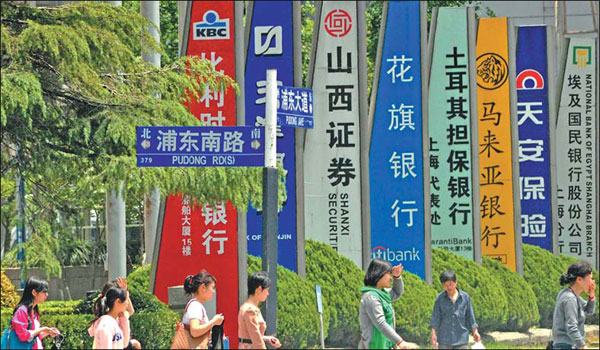China 'most promising' in FDI
|
Outdoor ads for foreign and Chinese financial institutions are seen in Shanghai. Chinese companies are investing broadly in industries across the world, according to a United Nations Conference on Trade and Development report. Yan Daming / For China Daily |
Capital outflow continued to grow in 2012, reaching a record $84 billion
China moved up from the sixth to the third place in 2012 in terms of outward foreign direct investment - after the United States and Japan - while a recent survey listed the world's second-largest economy as "the most promising source" of FDI, according to an annual report of the United Nations Conference on Trade and Development.
The organization's World Investment Report 2013 - subtitled Global Value Chains: Investment and Trade for Development - was released on Wednesday.
In 2012, FDI outflow from China continued to grow, reaching a record $84 billion, while total outward FDI from East and Southeast Asia rose 1 percent to $275 billion amid a sharp decline in global FDI outflows, the report said.
China's outbound direct investment into non-financial sectors increased 20 percent year-on-year to $34.3 billion in the first five months of the year, while spending surged 28.6 percent year-on-year to $77.22 billion in 2012, according to the Ministry of Commerce.
"China's outward direct investment grew at a striking pace," said James Zhan, director of the investment and enterprise division of the UNCTAD. "Driven by multiple goals of exploring markets, enhancing corporate performance, acquiring natural resources and strategic assets, Chinese companies made very broad outward investments in different sectors and regions. It's worth noting that Chinese investment in the overseas infrastructure sector increased very fast."
Liang Guoyong, an economic affairs officer at the UNCTAD's investment and enterprise division, said that Chinese companies have become the targets of investment protectionism due to their fast-growing overseas investments, as well as the broad scope of the spending.
"The motivation of getting natural resources and strategic assets, including technologies and brands, easily left Chinese companies as the targets of protectionism, as China, at present, tends to invest in Europe and the US for advanced technology and brands," Liang said. "Mergers and acquisitions in the process often arouse employment concerns in the host countries. State-owned enterprises - the major drivers of China's outbound investment - were often easily targeted, which also accounted for the rising protectionism against China."
After Chinese meat giant Shuanghui International Holdings Ltd proposed to buy Smithfield Foods Inc - the world's largest pork producer - a number of US senators urged the Obama administration to consider whether the proposed $4.7 billion deal, the biggest takeover of a US company by a Chinese firm, posed a threat to the US food supply that could justify blocking it.
Meanwhile, FDI inflows to China declined 2 percent year-on-year to $121 billion in 2012, second only to the US, while China remains the top investment destination for transnational corporations in the medium term, the report said.
FDI in China's non-financial sectors declined 3.7 percent year-on-year to $111.72 billion in 2012, according to the Ministry of Commerce, while the first five months of the year saw FDI inflow in China edging up 1.03 percent year-on-year to $47.6 billion.
"The structure of FDI inflow to China has changed following the country's economic restructuring and industrial upgrading," Zhan said. "Owing to rising costs in the eastern region, some investment and production activities are being transferred into inland areas and the share of the central and western regions in China's total FDI inflow rose from 12 percent in 2008 to 17 percent in 2012."
He added that some low-end manufacturing plants are moving to Southeast Asian countries with lower costs than China, while FDI inflow to China's high-tech and advanced manufacturing sectors is increasing rapidly.
"The total number of foreign research and development centers in China doubled in the past five years and reached 1,800 at the end of 2012. The quality and structure of China's FDI kept improving," Zhan noted.
Liang added that transnational corporations are increasingly attracted to China due to the country's huge market and fast economic growth, as well as the opening up of its services sector.
China's economic growth eased in recent months as the new leadership steered the country to a more balanced and sustained growth path. GDP in the last quarter of 2012 increased 7.9 percent year-on-year, and it slowed to 7.7 percent in the first quarter of the year.
"With the improvement in FDI inflow, China kept enhancing its participation in global value chains," Zhan said.



















